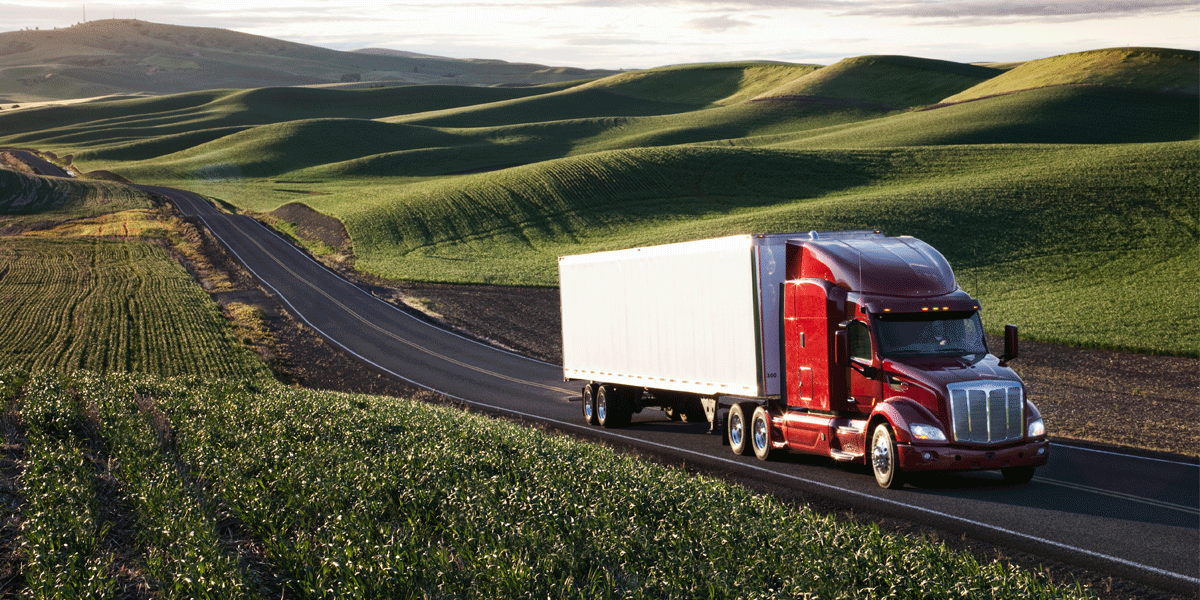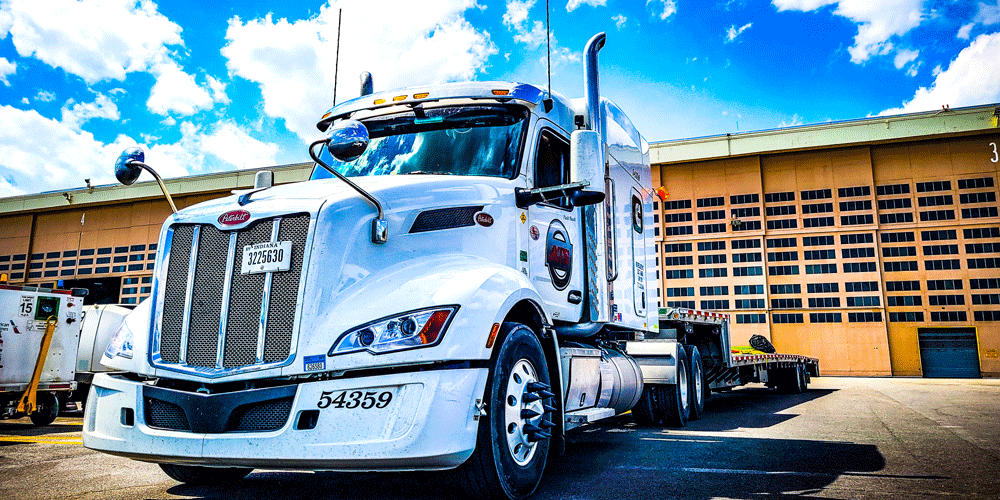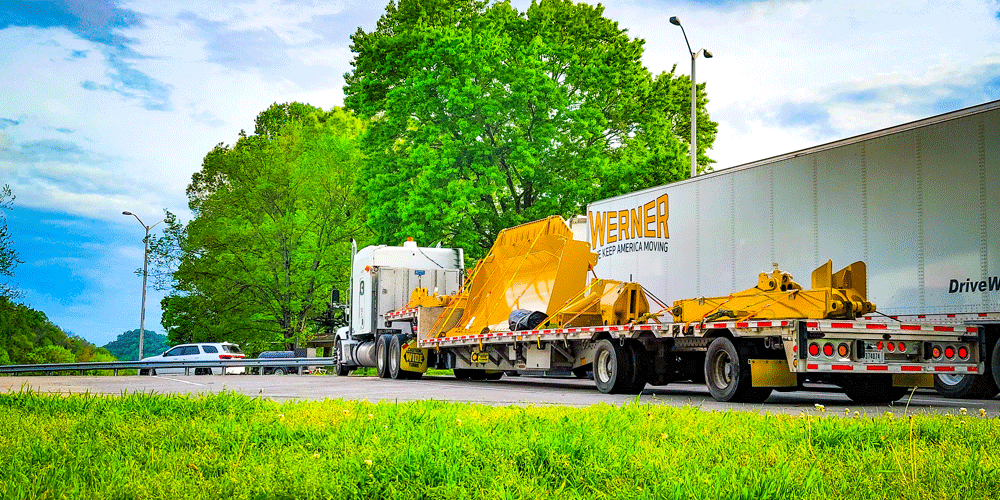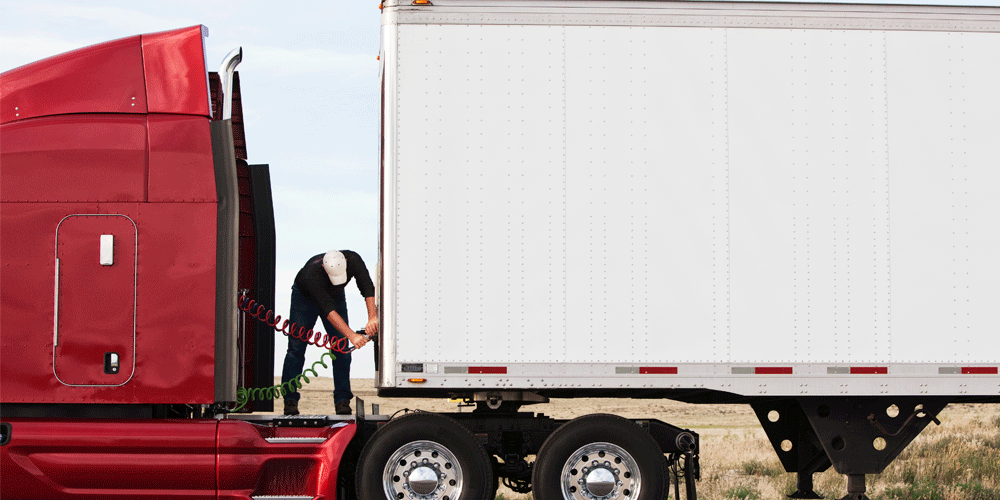A Semi-Truck Buying Guide (Freightliner, Peterbilt, Volvo)
- The Benefits of Freightliner Trucks
- The Benefits of Peterbilt Trucks
- The Benefits of Volvo Trucks
- Understanding the Truck Manufacturing World
- Questions to Ask When Buying a Truck
Pepsi versus Coke.
Ford versus Chevy.
Freightliner versus Peterbilt or Volvo.
There are some debates that people will probably go back and forth on for eternity, and the debate about which truck make and model you should drive as a truck driver fits into that category.
Do a quick Google search and you’ll find that everyone has an opinion on which semi-truck make and model is better.
- This one costs more!
- This one always has this one thing wrong with it!
- This one is cheap!
At Anderson Trucking Service (ATS), every day we help drivers like you choose a truck with the specs that will meet your needs and help you to be successful on the road.
Freightliner, Peterbilt, and Volvo are among the most popular semi-trucks on the road. As a former driver, I’m here to help you learn a little more about each of these trucks so you can feel good about your truck selection.
The Benefits of Freightliner Trucks
Freightliner is one of the most popular trucks around — specifically the Cascadia model.
They’re future-focused and aim to lead the industry in quality and innovation. In terms of their product testing, they far exceed other brands. They primarily build heavy-duty class 8 diesel trucks but they also build class 5-7 trucks.
A primary focus of Freightliner is to make the cost of ownership accessible to drivers so that they can make their business competitive. That means they have addressed the top factors to maximize profitability, which include fuel efficiency, connectivity, safety, quality, and uptime.
Freightliner is known for its robust dealer network. That means as a driver, you have access to new and manufactured parts and components. You can rely on excellent service and maintenance across the country if you have a breakdown. Their impressive dealer network means you’ll have better access to parts, which means less downtime and more uptime for you.
Freightliner is also unique in terms of how they manufacture their trucks. Their trucks run on the Detroit Integrated Powertrain. The engine, transmission, and axle are specifically engineered Detroit components that work together seamlessly to create an efficient system optimized for performance and reliability.
Each of these components is powerful on its own, but when they work together, they have unprecedented levels of performance which in turn boosts your fuel economy, safety, and reliability.
Freightliner Pros
- Lower cost of ownership compared to competitors
- Extensive dealer and service network, making repairs and maintenance easier
- Detroit Integrated Powertrain designed for efficiency and reliability
- Strong fuel economy
- Widely available parts, reducing downtime
Freightliner Cons
- More basic interior compared to Peterbilt and Volvo
- Some drivers feel the ride quality isn’t as smooth as premium brands
- Less customization compared to Peterbilt
The Benefits of Peterbilt Trucks
Peterbilt was founded in 1939 and aims to create purpose-built vehicles that last. They’re focused on ensuring that they’re an environmentally friendly company. They make both medium-duty and heavy-duty trucks. Peterbilt is an iconic brand known for its rugged and reliable products.
Peterbilt offers industry-leading technology features on each of its trucks, superior comfort, maneuverability, and value. The ergonomic interiors of Peterbilts offer best-in-class visibility.
Peterbilt also relies on SmartLINQ™ remote diagnostics, which is designed to monitor the health of your truck at all times. If there’s an issue, the system sends an alert to your driver manager or dispatcher (if you have one) and the closest Peterbilt dealership.
Peterbilt trucks rely on an integrated PACCAR Powertrain. This differs from the Freightliner Detroit Integrated Powertrain. Most Peterbilts have a Cummins engine, but there are a ton of customizations that can be made with truck specs.
A note on PACCAR, Cummins, and Detroit: PACCAR engines are manufactured in-house and are known for their durability and fuel efficiency. They’re used in Kenworth and Peterbilt trucks. The powerful, reliable Cummins engines are not manufactured in-house, so they’re used in a variety of trucks — no matter the brand. Detroit engines are known for their raw power.
Peterbilt Pros
- Known for durability and long lifespan
- High resale value due to brand reputation
- Comfortable, driver-friendly interiors with excellent visibility
- Customization options available to tailor to specific needs
- SmartLINQ™ remote diagnostics for proactive maintenance
Peterbilt Cons
- Typically more expensive upfront
- Smaller dealer network compared to Freightliner
- Most models use PACCAR or Cummins engines, which some drivers prefer less than Detroit engines
The Benefits of Volvo Trucks
Volvo has been a major player in the trucking industry for decades, known for its focus on safety, fuel efficiency, and driver comfort. Volvo Trucks North America is part of the larger Volvo Group, which also manufactures construction equipment, buses, and cars.
One of Volvo’s biggest selling points is its commitment to safety. They were among the first to introduce features like automatic emergency braking and lane-keeping assist in semi-trucks, setting the standard for accident mitigation technology.
Comfort is another area where Volvo stands out. Volvo trucks are known for their spacious, ergonomic cabs with a quiet ride, making them a favorite among long-haul drivers. The VNL series, for example, offers premium interior options to reduce driver fatigue.
Volvo’s powertrain is also unique. They use the Volvo Integrated Powertrain, featuring Volvo’s own engines and the I-Shift automated manual transmission. The I-Shift is designed to optimize fuel efficiency by automatically selecting the most efficient gear, which can be a game-changer for fuel-conscious owner-operators.
Volvo’s dealer network isn’t as large as Freightliner’s, but they still offer strong parts availability and service support. They also provide Remote Diagnostics, which allows fleets and drivers to monitor their trucks in real-time and detect potential maintenance issues before they become costly breakdowns.
Mack is owned by Volvo now, so if you’re looking into a Mack truck, know that you’ll get a similar truck but with a fancier look.
Volvo Pros
- Industry leader in safety features and accident mitigation technology
- Quiet, comfortable ride with ergonomic design (ideal for long-haul drivers)
- Volvo I-Shift transmission optimizes fuel efficiency and driver ease
- Strong aerodynamics improve fuel economy
- Remote Diagnostics helps detect maintenance issues before they cause breakdowns
Volvo Cons
- Higher repair costs due to proprietary parts
- Smaller dealer network, which can make finding parts and service more difficult
- Some drivers prefer manual transmissions over the I-Shift’s automated system
A Quick Look Inside the Truck Manufacturing World
Brand loyalty is certainly an important factor that many drivers consider when choosing their next truck. There are some drivers who simply must drive a Freightliner or they must drive a Peterbilt because that’s the only thing they’ve driven and that’s the only thing their family members have driven.
However, before you can make your decision between Freightliner, Peterbilt, and Volvo — or even Kenworth and Western Star — you must first understand more about the truck manufacturing world.
The Class 8 truck manufacturing world isn’t the same as the automobile manufacturing world, where each company manufactures its vehicles differently.
Only seven truck manufacturers are serving the U.S. and they’re all sourcing the same parts from around the world from similar manufacturers. Several of these companies share ownership.
That means that, depending on how you spec your truck, you can end up with a very similar truck whether it is a Kenworth or a Volvo or a Peterbilt.
For instance, both Kenworth and Peterbilt trucks are manufactured by PACCAR, so they both use PACCAR engines. You could build out a truck and cherry-pick the parts and the end result would be two very similar trucks.
While the truck brand is important, the most important thing to consider when you’re choosing your truck is what you’ll be using the truck for.
A Semi-Truck Buying Guide: Questions to Ask When Buying a Truck
The next time you head to a dealer to buy, lease, or custom-build a semi-truck, you must consider a few important factors — not just the brand.
Whether you’re building out a truck that’ll be ready in a few months or you’re purchasing a used truck, consider how the truck’s features will meet your unique needs. Brand might be important to you but spec the truck to your needs.
When you’re speaking with the salesperson, make sure you keep these ideas in mind and ask the right questions to get the make and model you need to succeed.
Ask the following questions:
- Is it suited to your application?
- Does it fit into your budget?
- Is it comfortable?
- How does it drive?
- Does it have a warranty?
- Does it have good safety features?
Is it Suited to Your Application?
If the truck can’t move the freight you need it to, it’s not right for you.
No truck is one size fits all. The number one thing you should consider when you’re building out your truck or buying a truck is whether or not the truck can handle the job you need to do. Your truck needs to have the power to handle the freight you plan to haul.
When you walk into a dealership, it’s your job to make sure the salesperson knows how your truck will be used. Consider the following:
- What will you be hauling?
- Are you hauling general freight or over-dimensional loads?
- Are you going to be driving through the mountains?
- Will you primarily be driving through the Great Plains?
- Are you a long-haul, short-haul, or local driver?
If you’re a heavy haul driver, you need a more powerful truck with more horsepower. If you’re driving through the mountains, you’ll need a different gear ratio in your truck. When you take these factors into account, you’ll be buying a truck matched to your specific needs.
Does it Fit Your Budget?
You may want the fanciest truck, but you have to be realistic about your budget.
When you’re meeting with the salesperson, be upfront about your budget from the start. They can provide you with a list of truck options that fit within your budget and you can go from there.
There’s nothing worse than finding your dream truck with every feature you desire only to find out there’s no way it’ll ever fit into your budget.
Is it Comfortable and Spacious?
Comfort and space are huge, especially when you’ll essentially be living in the truck. There are different sizes and shapes of sleeper cabs and you can customize how much storage is in the truck.
If you’re purchasing a used vehicle, look inside the cab, test it for comfort, and see if it suits your storage needs. For instance, some trucks come with a coffin sleeper (a small, cramped, and basic sleeper). This style simply won’t work for some drivers.
How Does it Drive?
You should test drive the truck if possible. If you’re building out a new truck, see if you can test drive a model similar to the one you’re going to be purchasing. The truck should ride smoothly and maneuver easily.
A quiet truck is preferable. Studies show that louder trucks can lead to more driver fatigue.
Does it Have a Warranty?
A warranty is an important consideration and your options will vary depending on if you’re purchasing or leasing, and if you’re looking at older or newer trucks.
Talk to the dealership about warranties and make sure it suits your needs.
Ask the following:
- What’s the warranty on the truck?
- What does it cover?
- What does it cost?
- How do I maintain the warranty?
Does it Have Good Safety Features?
Safety features are important. Whether looking at a newer or older vehicle, ask about its safety features.
All the newer trucks will have accident mitigation equipment and modern safety features, but some of the older ones might not. Accident mitigation technology is an important feature for some drivers, while others may not have a preference.
Related: A guide to buying your first semi-truck
Explore Your Lease Options
When it comes down to it, Freightliners, Peterbilts, and Volvos are great trucks and can be built to meet your unique needs.
Just be sure when you’re building out or selecting a truck that you carefully consider what you’ll be using the truck for and how that should carry over to the design of the truck. Be honest with the dealership about what you need.
Want help finding the right truck for your needs? At ATS, we work with Competitive Equipment Sales (CES). You can lease a truck with CES and sign on to haul freight with ATS.
Explore the lease-purchase program and see how we can get you in the driver’s seat faster.




